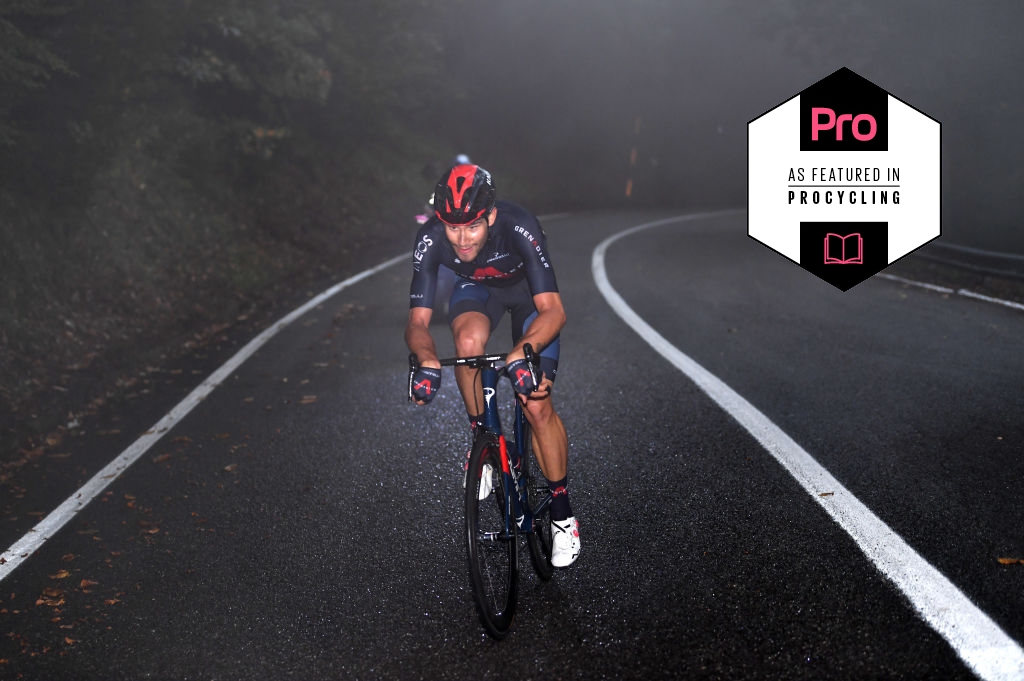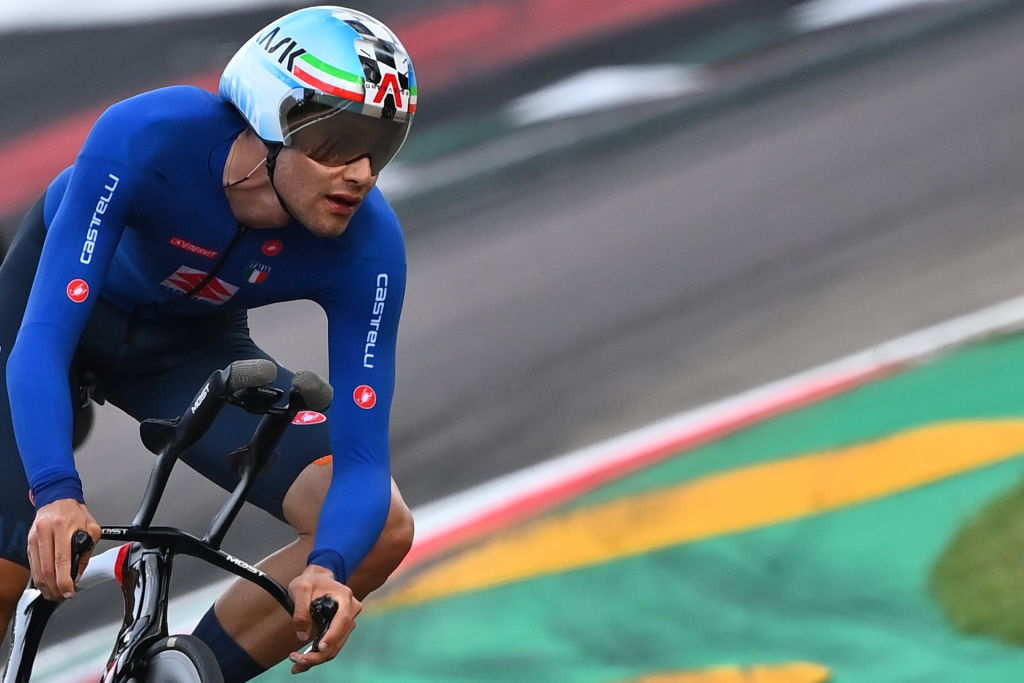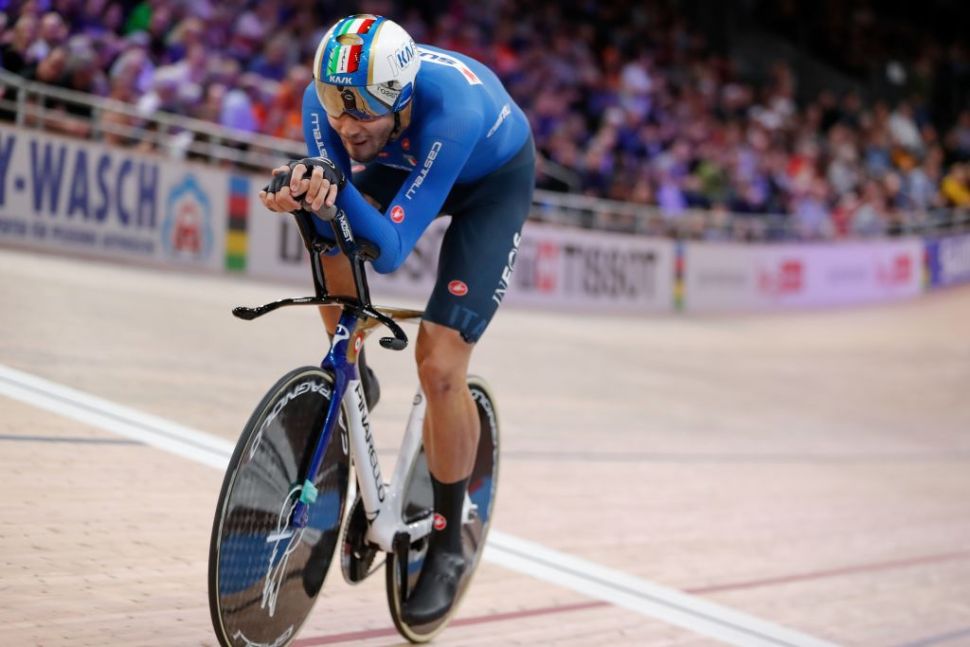Filippo Ganna: The high wire artist
Procycling magazine meets track star turned double Giro stage winner Filippo Ganna

Filippo Ganna hopes to be the first sub-four minute individual pursuiter, all while balancing a nascent career on the road. Procycling meets a multi-talented rider who stands on the edge of greatness
This article appeared in Procycling magazine issue 268, May 2020.
Subscribe to Procycling magazine here from £3.47 per issue.
On 10 January, 89-year-old Guido Messina, the iconic pursuiter of the 1950s, passed away at home. Born into Sicilian penury in 1931, he’d caught a ferry to the mainland armed only with his bike. He’d settled in Turin, and the rest is history. Messina won Olympic gold and three pursuit World Championships, and in the process become an authentic European superstar. Track cycling mattered a very great deal back then, and Messina was one hell of a track cyclist.
In the fullness of time, Messina became the president of the Piedmontese riders’ association. Each December they would organise one of those interminable Italian lunches, and the best of the local youngsters would be invited up onto the stage. They’d get to shake his hand, and there’d be a well-meaning round of applause from the old champions, the hacks and the men in suits. The kids would get a trophy with their name on it, mum and dad would gush, and there’d be a photo opportunity with the one and only pursuiter capable of beating Fausto Coppi. Everyone a winner.
Italy is an old-fashioned country, and most families here still encourage their kids to do sports. About 10 years ago, one of them, a gangly, slightly larruping, sweet-natured boy, clambered up onto the stage. His name was Filippo (‘Pippo’) Ganna, and we were informed that he came from a village on the shores of Lake Maggiore. We learned that his mum and dad were into water skiing and canoeing, respectively, and that Pippo had tried this, that and the other sport before settling on cycling.
At the ripe old age of nine, he’d taken it upon himself to join the local club. Then, in the Italian way of these things, he’d signed for a club run by an old pro. Florido Barale had rubbed shoulders with Gianni Bugno and Miguel Indurain; his father before him with Jacques Anquetil and… Guido Messina.
Get The Leadout Newsletter
The latest race content, interviews, features, reviews and expert buying guides, direct to your inbox!
Pretty soon Ganna was winning races, and in 2010 he won a big one on the Ghisallo. Thereafter he became a regular on stage with Messina. Each December we’d tuck into the fritto misto and tiramisu that he, an aspirant racing cyclist, daren’t even look at. The compère would reel off his latest conquests, and year on year they became more prestigious and more plentiful.
By 2016 he’d smashed it at the Paris-Roubaix Espoirs, and emulated Messina (and Coppi) in winning the individual pursuit at the World Championships. He wasn’t yet out of his teens, but UAE Team Emirates stuck a contract under his nose anyway. He’d ridden 4:16 to win that rainbow jersey in London, and that was 56kph. Yes, that’s right. 56kph. Aged 19. On what amounted to a Madison bike.
Two years on he shaved three seconds off his time, and won himself a second rainbow jersey. Now Team Ineos came calling, and in 2019 he won bronze in Yorkshire at the World Championships time trial, over 55 up-hill-and-down-dale kilometres in Yorkshire. He took some of that form to Minsk for a track World Cup event last year, and smashed the IP record twice in a day.
Historical comparisons in timed cycling events are always illusory, so there seems little point even in trying. However the fact is that he propelled a bike over four kilometres at almost 60kph for 4:02.647, and he did it at sea level. Nobody had come even remotely close to matching that even at altitude and so, as he prepared for the Track Worlds in Berlin this March, we were in uncharted territory.
Prior to his accession nobody – least of all the great Messina – could have conceived that a human could beat four minutes for the individual pursuit. Of course, the Pinarello Bolide is an extraordinary tool and these days we understand aerodynamics, sports science, air pressure and all the rest of it. It’s just that 60kph over four kilometres never seemed humanly possible. Did it?

He’s good company, Ganna, and his smile is still as wide as Lake Maggiore. He still lives at home with his folks, and he’s still a regular at the Christmas lunch. That may seem insignificant, but actually it’s anything but. Two other local pros, Fabio Felline and Diego Rosa, are residents in Monaco. Neither is a big winner, but aged 29 and 30 they’ve each built solid, highly remunerated careers in the WorldTour. They live in Monaco because the weather and taxation are beneficial, but mainly because they can afford to.
Ganna can’t do that yet, and that can’t but inform his career trajectory. He’s a bike rider with a colossal engine, and had he operated during Messina’s era he’d have been a European sporting deity earning a fortune. However he didn’t so he isn’t, and that tells us all we need to know about the current cycling paradigm. His is an endangered species, and his habitat is under threat. Put simply, there’s no money in track cycling, and a doubtful long-term future. As he ruminated on the probability of going under four minutes in Germany, he’s fairly clear it might be his one and only chance.
“The first thing is that I know now that it can be done, and I know that I’m the person best placed to do it. I almost did it with a week’s preparation in Minsk, just by holding my Worlds form as best I could,” he says. “Bear in mind, though, that the Worlds was over 55 kilometres, ergo over an hour. I did Minsk off the back of that, where this time I’m preparing specifically for those four minutes. I know the track probably won’t be as fast as Minsk, but if I train well and stay healthy I ought to able to produce more power.
“If it doesn’t happen in Berlin I’ll probably do a week or so at altitude, and then come back and try to do it at sea level. I know I could break it easily at altitude, but also it wouldn’t feel as complete. The problem is that I only have a small window to do it in, because after Berlin I have to commit totally to the Olympics in Tokyo. I’ll be riding the team pursuit for my country, and all the time Ineos will be paying my wages.”
What he’s saying, in a roundabout way, is that at some point he’s going to have to knuckle down and justify his salary, and the postponement of Tokyo 2020 doesn’t make that simpler. Ineos are making positive noises about renewing, but he’s conscious that he needs to start delivering serious results on the road.
“I love the track, but it’s not like it was in Messina’s day. Guys like him earned most of his money from track meets because there were more of them. Nowadays there’s only the World Cup, Euros and Worlds and the Olympics, and they’re not appearance based. I don’t want to take a step down on the road. I ride for the world’s best team, and I can’t afford to jeopardise that,” he says.
He’s a lucky guy, Ganna, and he knows it. His track ambitions are contingent upon an intricate four-way dialogue between him, his agent Giovanni Lombardi, Ineos DS Dario Cioni and Marco Villa, the boss of the Italian track cycling programme. Though the material benefit to his trade team of the track exploits is negligible, Cioni is willing to accommodate it.
That means working with Villa to produce a purpose-built road programme, in effect to take a punt on Ganna’s long-term potential. They have the budget and roster to indulge him for now, but it goes without saying that they won’t do it indefinitely. Ganna will turn 24 in July, and sooner or later that power he has is going to have to be deployed at the pointy end of the spring classics, in the big time trials and in the hard yards of the grand tours.

The paradox of all of this is that, objectively, track cycling ought to be doing well. It’s a much more intimate experience than road cycling, and many would argue a much better spectator sport. There’s a lot to love about it, not least the sheer variety. The only thing it currently lacks, Elia Viviani aside, is superstar riders. We know – because they’ve already proved it – that guys like Geraint Thomas and Rohan Dennis ought to be great trackies. A team like Ineos know it as well, but the distended road season and the marginalisation of the track which the UCI initiated back in the 1960s makes it difficult to take part in both.
For his part, Ganna admits that he loves the process and rigour of pursuiting. He’s in control of (almost) all the moving parts, and that acts as a catalyst for the sort of critical thinking which is often absent on the road.
“I like the stuff you can do around the pursuit – the marginal gains stuff, if you like – but also the purity of the ride itself,” he says. “Once you’re on the thing the variables are minimal, and if you’re doing it right the challenge should be personal. In reality you shouldn’t actually be concerning yourself with your opponent, because he’s not something that’s within your control.
“The issue there is that ignoring him is counterintuitive, particularly once you start to get within striking distance. You want to catch him, and that conflict is the heart and soul of pursuiting. Your instinct is always to try to push even harder, but of course you only have 10 tenths. So the whole thing is psychological as well as physical.
“When you’re a kid learning to cycle you don’t know anything, but the instinct is simply to go as fast as you can. Racing against other people comes later, and it’s really a consequence. It’s much more intricate and much more complex, but it’s rooted in the innate desire to go faster each time you ride.”
These are all classic time triallist tropes, but he’s right that road cycling’s development was – and still is – prefigured by them. The architects of modern, power-based training techniques were a bunch of Italian sports scientists working on Moser’s 1984 attempt to break the Hour record. Moreover all bike races, from the kilometre time trial to Paris-Roubaix, are essentially about speed. We talk a lot about tactics in cycling, but the more of them there are the further we get from spectacle. And, more importantly, from the physical truth which is the bedrock of all sports.
Regardless, the reality is that there simply isn’t enough track cycling for someone like Ganna to make a decent living from it. He knows he has to shelve it, at least until the next Olympic cycle: “My situation is different to the other guys on the team. Ours is a road team, and people are paid according to the results they produce there. It’s not like that for me, because I get a pat on the back if I do well on the track. I’m lucky that they’re supportive, because it means I can commit fully to Berlin and then Tokyo. It’s seven months of work for two four-minute efforts, neither of which are for my trade team.
“If I can contribute along the way then great, but by definition I’m less present and less focused than my team-mates. From next season – if they still want me – it has to be all about the road. Tom Boonen was my idol growing up, and once this is done Roubaix will be the dream,” Ganna says.
What he’s doing is wonderful for the old lags who grew up watching Messina and co, and who line up each December to wish him well. They’re able to trace the line from Coppi through Messina, and on to the great Roger Rivière. Then Hugh Porter and Moser himself, the latter who was the individual pursuit world champion back in 1976.
Next to Chris Boardman, Graeme Obree and Bradley Wiggins, track cycling icons all. However his patronage of the event is also significant in the here and now because, notwithstanding the UCI’s folly in eliminating it as an Olympic discipline, the individual pursuit is the very best of track cycling. The names above are simply testament to that, and Ganna’s attempt to break four minutes is deference to the fact.
Filippo Ganna has been walking a professional and financial tightrope these past few years, but if he can one day break the four-minute barrier in the individual pursuit, he’ll have achieved cycling greatness. Ganna may become cycling’s Roger Bannister and that, whichever way you look at it, will be quite something.
If you like what you read, why not subscribe to Procycling magazine? As part of our holiday subscription offer, you can get the magazine for as little as £3.47 per issue. Procycling magazine, the best writing and photography from inside the world’s toughest sport.